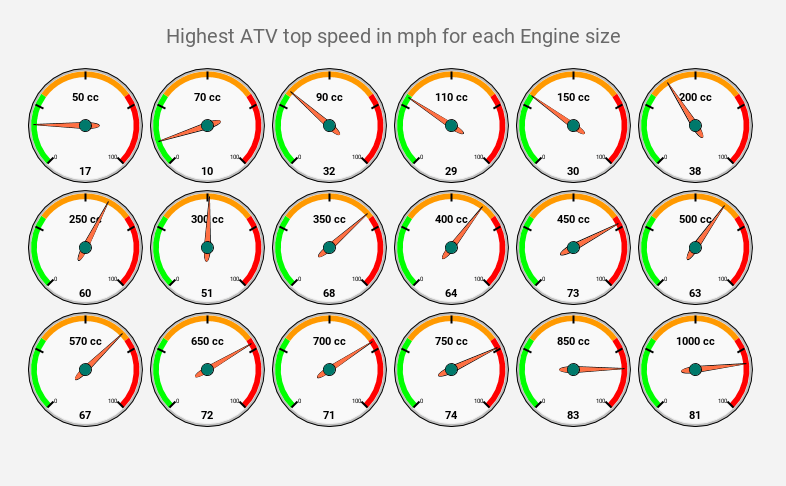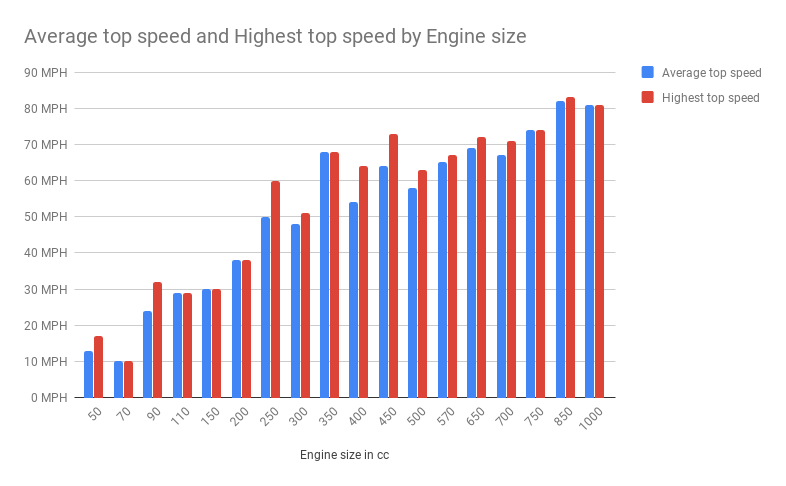Anyone new to ATVs will, at some point, wonder how fast they can go. It’s not likely that you will be riding at these speeds very often, but it’s just one of these things we want to know out of pure curiosity.
Or, maybe you are in the process of buying a new four-wheeler and want to make sure you won’t get disappointed by the performance of the bike size you are getting.
You typically won’t get these numbers from the manufacturers, so I did a little digging to find as accurate data as possible.
The most powerful sports and utility ATVs can reach top speeds of 80mph (128km/h). Moderate-sized models average at about 65 mph (104km/h). Youth ATVs have speed limiters so the parent can decide exactly how fast they can go.
Continue reading to learn the top speed of different models, how to deal with speed limiters, and how to increase the topå speed of an ATV.
Comparing Top Speeds of Different ATV Engine Sizes
These are the top speeds of the fastest stock ATVs I could find within each cc engine size. My research included most of the major brands.

The above chart only shows the fastest of the fastest.
To better understand what top speed to expect when getting a specific engine size, I’ve calculated the average top speed regardless of your chosen brand. I’ve included each manufacturer’s fastest model within each engine size in the comparison.
Note that many manufacturers have several models with the same engine size, but the difference in top speed between the two can vary by 5-10mph. In this comparison, I’ve included picked only the fastest models.

At this point, you may be eager to know what make and model achieves these speeds.
Below is a data sheet showing how fast each model goes based on reported user experience. Most but not all models are available on the market today.
Why Won’t Manufacturers Provide ATV Top Speeds?
For all practical purposes, as long as the bike does 50 MPH safely, you do not need it to go any faster.
But if you decide to push it even further regardless, you will find that it’s neither comfortable, practical, nor very safe. It also makes a severe impact on the fuel economy.
When you research different ATV models, you will notice that most manufacturers won’t state their machine’s top speed in their spec sheets (except with speed-limited youth models to show how slow they can go).
And they have good reasons for not focusing on blazing top speeds.
ATVs are not designed very well to be used at high speeds. They are meant to provide a lot of low-end power, which is why they need big engines. However, they are not meant to set any speed records.
The suspension is too soft, the tires are too aggressive, and the CVT transmission is non-ideal for higher speeds. The relatively short wheelbase and track width compared to a car also negatively affect high-speed performance.
So the manufacturers do not want riders pushing to reach potential top speed, as it’s not what the machines are designed for and could end in disaster.
Most manufacturers provide disclaimers similar to those on Can-Am spec sheets: “Avoid excessive speed. ” And they do so for a reason.
If it’s speed you’re looking for, a motorcycle or a fast car is a far better alternative.
But What About Quad Racing?
Racing quads are equipped with upgraded suspension, have a wide tire width, and are ridden by experienced riders. These cannot be compared to your average stock utility or recreation bike.
Some sports models have better suspension from the factory, but it is still not a vehicle designed for chasing high speeds.
ATV Speed Limiters and the Actual Top Speed
Many ATVs come with various types of speed limiters. You’ll find this even on “unrestricted” top-performance bikes like the Polaris Scrambler.
But the real purpose of why they are installed varies somewhat depending on what type of bike you are getting.
You’ll often find that it’s not the engine size (displacement) limiting how fast the quad goes. There is usually plenty of power available for even higher speeds.
But the speed needs to be restricted at some point to protect those of us who don’t understand the extreme dangers of doing these speeds. So they install speed limiters.
The same applies to most cars, motorcycles, and other high-performing machines. Usually, the top is set so high that the average user never notices, as they are never going this fast.
But it helps to explain why there are noticeable variations in top speed on quads with identical engine sizes but from different manufacturers in some cases.
You will even find bikes with smaller engines that outrun the bigger ones. Often this is likely due to a limiter set at different maximum speeds.
I strongly advise against messing with the top-speed limiter on these bikes. It is there for a good reason!
ATV Speed Limiter Types
ATV speed limiters can be mechanical, electronic or both
A mechanic speed limiter uses a mechanical barrier to prevent you from applying full throttle.
This can be an adjustable screw on the handlebar, plastic parts inside the carburetor, or shims limiting airflow in various places inside the engine. Other types exist as well.
Electronic limiters are typical on bikes with electronic fuel injection. The fuel injection system gets notified to cut back on fuel when the ATV reaches the set limit.
Speed limiters are installed on children’s and youth ATVs as a critical safety feature to protect beginners and inexperienced riders.
Some bikes come with adjustable limiters so that the parent can increase speed gradually as the riders riding skills and experience increase.
Most of the smaller-sized ATVs are capable of speeds in the range of 30 mph with some light tuning, removing speed limiters, etc.
I’m not telling you this because I advise you to do so, but so that you’ll understand why there are such significant variations in the top speed of the presumably identically sized smaller bikes. In most cases, it is not due to any significant differences in engine power output.
For older beginners, Can-Am includes a learning key with a code that electronically limits the bike’s speed. This is a great safety feature I hope more manufacturers will offer in future models.
ATV Top Speed With Tracks
When you install tracks on the quad, you simultaneously give up a lot of the speed. As a general rule of thumb, you may expect the top speed to drop by about 50% due to the sprockets’ different output ratios.

Because of this, the internals of your bike needs to move twice as fast to maintain the same speed when running in the same gear and with the same RPMs.
It’s wise to remember this when you’re chasing top speed with your new tracks. It puts a lot of strain on your gearbox, diffs, and CV joints.
How to Increase ATV Top Speed
If you, despite the warnings, still wish to increase your bike’s top speed, there are several ways you can go about it. Disclaimer! All modifications are done at your own risk! I do not recommend any of them.
Change Tire Dimensions
Bigger tires have a bigger circumstance, which means the tire travels farther each revolution. This will effectively increase the top speed of your bike.
Remember to install a clutch kit if you increase tire diameter by over a couple of inches. If you don’t, you will lose much power and may face belt slipping issues and burning belts.
Related: Putting Bigger Tires on an ATV: All You Need to Know
Change the Gearbox Gearing Ratio
If your ATV has a gearbox with sprockets and chains, you can change one of the sprockets to increase your top speed. However, this is most commonly done to reduce maximum speed while improving acceleration by installing a smaller sprocket.
Install a Racing Clutch
By installing a racing clutch, you can choose one that uses different dimensions of clutch sheaves, altering the bike’s top speed according to your needs.
Increase Engine Power Output
I won’t go into the details on how to increase the power output of your bike’s engine, as this subject deserves a post of its own. But doing so will also give you an improvement in top speed.
Remove the Speed Limiter
This one is quite obvious, but removing it will improve your top speed if your bike has any speed limiter installed. Be aware you may void your warranty and break a few laws if you decide to go this route.
Mechanical speed limiters are the easiest to remove as it usually only require removing the component limiting your throttle response.
However, if your bike has an electronic speed limiter, you may need reprogramming of the ATV to turn off the limiter. Some dealers do this for you; others don’t.
For my Polaris Sportsman XP 1000, no software was available to remove its top speed limiter of 60km/h (37,3 mph). This particular bike is sold as a tractor required by law (Norway) not to go any faster than this.
Change the Gearing Ratio
If your bike has an open sprocket and chain, altering the top speed is easy. Increasing the size of the front sprocket (clutch) and reducing the size of the rear sprocket (axle) will give you a higher top speed.
People into quad racing tweak gearing ratio to find the optimal setup for each track they are racing.
Tracks with long stretches require higher top speeds, while tracks with many turns benefit from better acceleration at the expense of higher top speeds.
Reflash the ECU
As I mentioned, most bikes have an electronic speed limiter to prevent riders from attempting speeds much higher than the machine is designed for.
The Polaris Scrambler XP 1000 limiter kicks in at about 80mph, but there have been reports of people reaching speeds in the range of 100mph simply by flashing new software to their ATV’s ECU.
The Scrambler XP 850 even has a higher stock top speed, with the limiter reportedly set at 83 mph.
Again, I strongly advise against doing these modifications. And quite frankly, I don’t see the point unless you are into serious racing. And don’t get me wrong, I love speed. Just not these kinds of speeds on an ATV.
Related Questions
What is the world’s fastest stock ATV on the market?
The fastest stock ATV you can buy today is the Polaris Scrambler XP 1000. With its 90 hp, it’s been clocked at speeds over 80 mph (128 km/h)
What is the fastest ATV in the world?
According to the Guinness Book of world records, the fastest speed ever achieved by an ATV was 196.19mph (315.74 km/h). The rider was Terry Wilmeth, and the bike was a modified Yamaha 700 Raptor with a hybrid rocket thruster.


